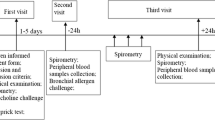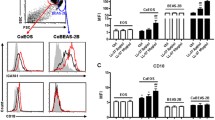Abstract
Serine proteases play an important role in inflammation via PARs. However, little is known of expression levels of PARs on monocytes of allergic patients, and influence of serine proteases and PARs on TNF-α secretion from monocytes. Using quantitative real-time PCR (qPCR) and flowcytometry techniques, we observed that the expression level of PAR-2 in monocytes of patients with allergic rhinitis and asthma was increased by 42.9 and 38.2 %. It was found that trypsin, thrombin, and tryptase induced up to 200, 320, and 310 % increase in TNF-α release from monocytes at 16 h, respectively. PAR-1 agonist peptide, SFLLR-NH2, and PAR-2 agonist peptide tc-LIGRLO-NH2 provoked up to 210 and 240 % increase in release of TNF-α. Since SCH 79797, a PAR-1 antagonist, and PD98059, an inhibitor of ERK inhibited thrombin- and SFLLR-NH2-induced TNF-α release, the action of thrombin is most likely through a PAR-1- and ERK-mediated signaling mechanism. Similarly, because FSLLRN-NH2, an inhibitor of PAR-2 diminished tryptase- and tc-LIGRLO-NH2-induced TNF-α release, the action of tryptase appears PAR-2 dependent. Moreover, in vivo study showed that both recombinant cockroach major allergens Per a 1 and Per a 7 provoked upregulation of PAR-2 and PAR-1 expression on CD14+ cells in OVA-sensitized mouse peritoneum. In conclusion, increased expression of PAR-2 in monocytes of AR and asthma implicates that PAR-2 likely play a role in allergy. PAR-2- and PAR-1-mediated TNF-α release from monocytes suggests that these unique protease receptors are involved in the pathogenesis of inflammation.







Similar content being viewed by others
Abbreviations
- PARs:
-
Proteinase-activated receptors
- MMP:
-
Matrix metalloprotease
- SBTI:
-
Soybean trypsin inhibitor
- OVA:
-
Ovalbumin
- BSA:
-
Bovine serum albumin
- FCS:
-
Fetal calf serum
- AR:
-
Allergic rhinitis
- HC:
-
Healthy control subjects
- ARIA:
-
Allergic Rhinitis and its Impact on Asthma
- PBMC:
-
Peripheral blood mononucleated cells
- MACS:
-
Magnet-activated cell sorting
- CASE:
-
Cellular activation of signaling ELISA
- ERK:
-
Extracellular signal-regulated kinase
- TGF:
-
Transforming growth factor
- TNF:
-
Tumor necrosis factor
- VCAM:
-
Vascular cell adhesion molecule
References
Asokananthan N, Graham PT, et al. Activation of protease-activated receptor (PAR)-1, PAR-2, and PAR-4 stimulates IL-6, IL-8, and prostaglandin E2 release from human respiratory epithelial cells. J Immunol. 2002;168:3577–85.
Busse PJ, Zhang TF, et al. Decrease in airway mucous gene expression caused by treatment with anti-tumor necrosis factor alpha in a murine model of allergic asthma. Ann Allergy Asthma Immunol : Off Publ Am College Allergy Asthma Immunol. 2009;103:295–303.
Colognato R, Slupsky JR, et al. Differential expression and regulation of protease-activated receptors in human peripheral monocytes and monocyte-derived antigen-presenting cells. Blood. 2003;102:2645–52.
D’Andrea MR, Rogahn CJ, et al. Localization of protease-activated receptors-1 and -2 in human mast cells: indications for an amplified mast cell degranulation cascade. Biotech Histochem : Off Publ Biol Stain Commission. 2000;75:85–90.
Day SB, Ledford JR, et al. German cockroach proteases and protease-activated receptor-2 regulate chemokine production and dendritic cell recruitment. J Innate Immun. 2012;4:100–10.
Demoly P, Allaert FA, et al. Validation of the classification of ARIA (allergic rhinitis and its impact on asthma). Allergy. 2003;58:672–5.
Esnault S, Malter JS. Hyaluronic acid or TNF-alpha plus fibronectin triggers granulocyte macrophage-colony-stimulating factor mRNA stabilization in eosinophils yet engages differential intracellular pathways and mRNA binding proteins. J Immunol. 2003;171:6780–7.
Frasca D, Landin AM, et al. Tristetraprolin, a negative regulator of mRNA stability, is increased in old B cells and is involved in the degradation of E47 mRNA. J Immunol. 2007;179:918–27.
He S, Zhang H, et al. Self-amplification mechanisms of mast cell activation: a new look in allergy. Curr Mol Med. 2012;12:1329–39.
He S, Zhang Z, et al. Analysis of properties and proinflammatory functions of cockroach allergens per a 1.01 s. Scand J Immunol. 2011;74:288–95.
Heyman M, Desjeux JF. Cytokine-induced alteration of the epithelial barrier to food antigens in disease. Ann N Y Acad Sci. 2000;915:304–11.
Kim JY, Sohn JH, et al. Alveolar macrophages play a key role in cockroach-induced allergic inflammation via TNF-alpha pathway. PLoS One. 2012;7:e47971.
Knight DA, Lim S, et al. Protease-activated receptors in human airways: upregulation of PAR-2 in respiratory epithelium from patients with asthma. J Allergy Clin Immunol. 2001;108:797–803.
Kuwahara I, Lillehoj EP, et al. Neutrophil elastase induces IL-8 gene transcription and protein release through p38/NF-{kappa}B activation via EGFR transactivation in a lung epithelial cell line. Am J Physiol Lung Cell Mol Physiol. 2006;291:L407–16.
Lee HM, Kim HY, et al. Up-regulation of protease-activated receptor 2 in allergic rhinitis. Ann Otol Rhinol Laryngol. 2007;116:554–8.
Leonardi A. The central role of conjunctival mast cells in the pathogenesis of ocular allergy. Curr Allergy Asthma Rep. 2002;2:325–31.
Li T, Wang H, et al. Induction of interleukin-6 release from monocytes by serine proteinases and its potential mechanisms. Scand J Immunol. 2006;64:10–6.
Lohman RJ, Cotterell AJ, et al. An antagonist of human protease activated receptor-2 attenuates PAR2 signaling, macrophage activation, mast cell degranulation, and collagen-induced arthritis in rats. FASEB J : Off Publ Fed Am Soc Exp Biol. 2012;26:2877–87.
Malamud V, Vaaknin A, et al. Tryptase activates peripheral blood mononuclear cells causing the synthesis and release of TNF-alpha, IL-6 and IL-1 beta: possible relevance to multiple sclerosis. J Neuroimmunol. 2003;138:115–22.
Mari B, Guerin S, et al. Thrombin and trypsin-induced Ca(2+) mobilization in human T cell lines through interaction with different protease-activated receptors. FASEB J : Off Publ Fed Am Soc Exp Biol. 1996;10:309–16.
Molino M, Barnathan ES, et al. Interactions of mast cell tryptase with thrombin receptors and PAR-2. J Biol Chem. 1997;272:4043–9.
Nieuwenhuizen L, Falkenburg WJ, et al. Stimulation of naive monocytes and PBMCs with coagulation proteases results in thrombin-mediated and PAR-1-dependent cytokine release and cell proliferation in PBMCs only. Scand J Immunol. 2013;77:339–49.
Ossovskaya VS, Bunnett NW. Protease-activated receptors: contribution to physiology and disease. Physiol Rev. 2004;84:579–621.
Page K, Hughes VS, et al. German cockroach proteases regulate matrix metalloproteinase-9 in human bronchial epithelial cells. Allergy. 2006;61:988–95.
Popovic M, Laumonnier Y, et al. Thrombin-induced expression of endothelial CX3CL1 potentiates monocyte CCL2 production and transendothelial migration. J Leukoc Biol. 2008;84:215–23.
Ramachandran R, Morice AH, et al. Proteinase-activated receptor2 agonists upregulate granulocyte colony-stimulating factor, IL-8, and VCAM-1 expression in human bronchial fibroblasts. Am J Respir Cell Mol Biol. 2006;35:133–41.
Rand MD, Lock JB, et al. Blood clotting in minimally altered whole blood. Blood. 1996;88:3432–45.
Schmidlin F, Amadesi S, et al. Protease-activated receptor 2 mediates eosinophil infiltration and hyperreactivity in allergic inflammation of the airway. J Immunol. 2002;169:5315–21.
Shimizu S, Gabazza EC, et al. Role of thrombin in chronic rhinosinusitis-associated tissue remodeling. Am J Rhinol Allergy. 2011;25:7–11.
Sun G, Stacey MA, et al. Interaction of mite allergens der p3 and der p9 with protease-activated receptor-2 expressed by lung epithelial cells. J Immunol. 2001;167:1014–21.
Thomas PS. Tumour necrosis factor-alpha: the role of this multifunctional cytokine in asthma. Immunol Cell Biol. 2001;79:132–40.
Uehara A, Muramoto K, et al. Neutrophil serine proteinases activate human nonepithelial cells to produce inflammatory cytokines through protease-activated receptor 2. J Immunol. 2003;170:5690–6.
Vestergaard C, Johansen C, et al. TARC augments TNF-alpha-induced CTACK production in keratinocytes. Exp Dermatol. 2004;13:551–7.
Von Mutius E. Presentation of new GINA guidelines for paediatrics. The Global Initiative on Asthma. Clin Exp Allergy : J Br Soc Allergy Clin Immunol. 2000;30(Suppl 1):6–10.
Wang H, He S. Induction of lactoferrin and IL-8 release from human neutrophils by tryptic enzymes via proteinase activated receptor-2. Cell Biol Int. 2006a;30:688–97.
Wang L, Luo J, et al. Induction of interleukin-8 secretion and activation of ERK1/2, p38 MAPK signaling pathways by thrombin in dermal fibroblasts. Int J Biochem Cell Biol. 2006b;38:1571–83.
Wang L, Luo J, et al. Induction of MMP-9 release from human dermal fibroblasts by thrombin: involvement of JAK/STAT3 signaling pathway in MMP-9 release. BMC Cell Biol. 2007;8:14.
Waserman S, Dolovich J, et al. TNF-alpha dysregulation in asthma: relationship to ongoing corticosteroidtherapy. Can Respir J : J Can Thoracic Soc. 2000;7:229–37.
Yang H, Li T, et al. Induction of tumor necrosis factor (TNF) release from subtypes of T cells by agonists of proteinase activated receptors. Mediat Inflamm. 2013;2013:165453.
Zhang Z, Zhang H, et al. Induction of T-helper type 2 cytokine release and up-regulated expression of protease-activated receptors on mast cells by recombinant American cockroach allergen Per a 7. Clinical and Experimental Allergy : Journal of the British Society for Allergy and Clinical Immunology. 2008;38:1160–7.
Zheng J, Liu W, et al. Suppression of connexin 26 is related to protease-activated receptor 2-mediated pathway in patients with allergic rhinitis. Am J Rhinol Allergy. 2012;26:e5–9.
Zhu W, Bi M, et al. Thrombin promotes airway remodeling via protease-activated receptor-1 and transforming growth factor-beta1 in ovalbumin-allergic rats. Inhal Toxicol. 2013;25:577–86.
Acknowledgments
This project was sponsored by the grants from the “12th Five-Year ” National Science and Technology Support Plan (2014BAI07B02), the National Natural Science Foundation of China (nos. 81172836, 81471592, 81472016 ); Major Science and Technology Platform for Institution of Higher Education in Liaoning Province (2014168); “Twelfth five-year” Public Welfare Industry Special Scientific Research Project (2015SQ00136); the National Natural Science Foundation of Liaoning Province (2014022027, 2014022019); Program for Liaoning Innovation Research Team in University (LNIRT, LT2013017); Climbing Scholar Project for Institution of Higher Education in Liaoning province (2013222); Allergic Disease Translational Medicine Research Centre of Liaoning Province (201341); Liaoning Provincial Engineering Research Centre for Diagnosing & Treating Inflammatory Disease (20141093); Clinical Capability Construction Project for Liaoning Provincial Hospitals ( LNCCC-A06-2014); and Science and Technology Planning Project of.
Suzhou (SYS201272).
Author information
Authors and Affiliations
Corresponding author
Ethics declarations
Conflict of interest
The authors declare that there is no competing interest regarding the publication of this article.
Additional information
Shuqing Ge and Tao Li contributed equally to the study
Rights and permissions
About this article
Cite this article
Ge, S., Li, T., Yao, Q. et al. Expression of proteinase-activated receptor (PAR)-2 in monocytes from allergic patients and potential molecular mechanism. Cell Biol Toxicol 32, 529–542 (2016). https://doi.org/10.1007/s10565-016-9353-x
Received:
Accepted:
Published:
Issue Date:
DOI: https://doi.org/10.1007/s10565-016-9353-x




